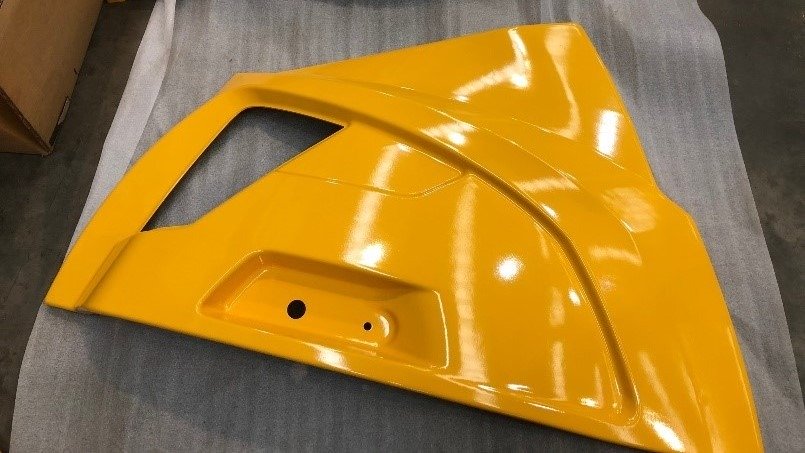Vac Forming is an incredibly effective method of manufacturing plastic mouldings for use in Automotive, Leisure, Construction, Municipal vehicles, and many other products uses and applications. This method is also very flexible and can be a valuable tool for producing high-quality plastic components.
Specifically, vacuum forming is a manufacturing process that consists of heating a sheet of extruded thermoplastic, such as ABS, HIPS, Polypropylene or HDPE over a mould tool.
The forming then occurs as the vacuum pressure pulls the heated plastic sheet material over a mould tool, allowing air to travel through and your part take the shape of the tooling, thus giving you the shape you require in a repeatable accurate manner.
Overall the top 3 benefits of vacuum forming are that it’s cost-effective, time-efficient and has greater design flexibility; making it an excellent process for manufacturing plastic products.
Benefits of Vac Forming
There are several advantages to vacuum forming in comparison to other methods of manufacture, such as lower tooling costs than large injection mouldings and faster turnaround time.
Vacuum forming is often the preferred method for research and development prototyping, in many instances being the best option for long-term production. This being instead of expensive large scale injection mouldings and slow to manufacture GRP products.
Moreover, the process can be valuable in lower and higher annual volumes of manufacture, from 200 parts PA, upwards of 100,000 parts PA.
When correctly applied, vacuum formed products can offer fantastic levels of part finish, impact resistance, decorative shapes and complex curves that traditional metals cannot achieve.
The sheet material can also be ordered in a range of colours, grains and textures, which can make the final product appear similar to other high-quality processes like injection moulding.
Further advantages associated with vacuum forming include:
- Products are available in a huge range of sizes
- Greater levels of detail and accuracy can be achieved
- Faster production speeds compared to fabricated assemblies
- Lower costs on manufacturing large products or components
- More selection on material and appearance
- Adaptive to the customer’s specification and requirements
- Flexible tooling design
- Quick changes with minimal added tool change cost
- Available in coloured, textured, and paintable plastic
- Anti Corrosion spray is not required
- Easier production than a comparable sheet metal fabrication
Applications of Vacuum Forming
Products made with vacuum forming are often used in place of components that are of a complex shape and are often fabricated from sheet metal.
Fabricated sheet metal products can require extensive operations consisting of welding, grinding and numerous finishes.
Likewise, when compared to other plastic forming operations such as resin transfer and fibre-reinforced plastics moulding, vacuum formed parts are often more favourable.
This is due to better cosmetics and economics which is why so many low volume manufacturers choose this option.
Vacuum forming is ideal for numerous applications, some examples include:
- Electronics
- Industrial
- Consumer Products
- Packaging
- Automotive
- Retail
- Display
- Construction
- Medical and Healthcare
- Outdoor Kiosks
- ATMs
- Railcars
Top 3 Advantages of Vacuum Forming
Vacuum Forming is a relatively common form of plastic moulding, in which a sheet of plastic is heated to its thermoforming temperature. The chamber in which the sheet sits over is filled with air which makes the plastic bubble, the tool is then lifted into the sheet at which point the vacuum chamber removes all the air. This forces the plastic to form around the tool creating the mould you need.
- Cost-Effective. The main advantage of vacuum forming over many other large moulding processes is the lower tooling costs. As the tooling has little to no moving parts, tools can be machined or cast from a single billet. As sheets of plastic are usually dedicated to a specific job, it also means waste is kept to a minimum to make the parts as cost-effective as possible.
- Design Flexibility. As the prototyping stages of vacuum tooling is quick and cost-effective, it means you can physically prove out your concept with Ureol tooling, this means you can refine it for your final production design. Plas-Tech has a full capability suite of prototype tool manufacture, quickly turning prototype tools around within a couple of weeks, followed by a full aluminium machine centre for production tools. This is all supported by a full team of experts to walk you through what you need.
- Time Efficient. Vacuum Forming is often an economical choice of production. With its quick production process, less time is spent between the design and the outcome of the product. Products are also introduced into the market much quicker.
Not only do we specialise in Vacuum Forming, but we’re also experts in our field. We also have a fantastic knowledge base and unrivalled technical and production capability.
For more information on Vacuum Forming or any of our other services, browse the rest of our website or email us at sales@plas-tech.co.uk or call us on 01964 544 544.
